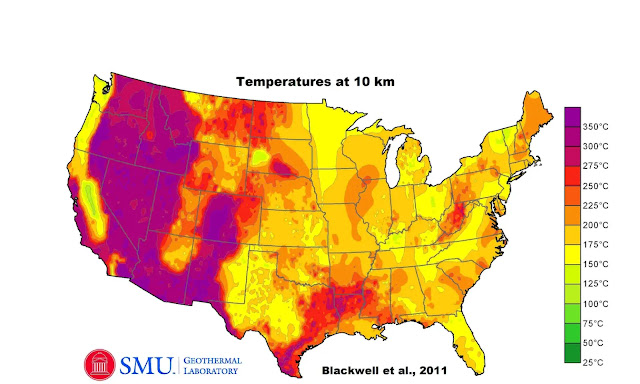In the political swamp that has ensnared our democratic republic a glimmer of something we haven’t seen for almost six years is on the horizon: the emergence of a fissure in the Republican party, which has lately been in the grips of Mr. Trump’s remarkably single-handed control as it morphed into the Cult of Trump. Finally, over 160 present and former leaders of the Republican party have said “Enough!”
Brutoco never went into detail on who the 160 were. However, more and more Republicans are shifting away from Donald Trump.
I subsequently submitted a proposal to tap the lava lake of Kilauea Iki, which erupted in 1959 and sent out fountains exceeding 1000 feet, to produce a different kind of geothermal energy. I was not successful, but have closely followed the efforts of Jeffrey Tester at the Los Alamos National Laboratory, who is now at Cornell.
What about drilling down three miles almost anywhere to access the heat of the Earth? He says: It's not a question of whether it's there--it is and it's significant. It's a question of getting it out of the ground economically.Of course, this future technology brings some risk. Quoting further:
In the U.S., Tester envisions a gradual switch to district heating by first transforming military bases, hospitals, schools, universities, and state and federal government complexes with public and private funding. One potential problem, though rare, is that deep drilling and fracking are known to induce seismicity and cause earthquakes. The famous example is an enhanced geothermal system drilled in Pohang, South Korea in 2017. Injecting fluid at high pressure to fracture the hot geology to release heat caused a 5.4-magnitude earthquake — the strongest in the area’s recent history — that injured 135 people and caused nearly $300 million in damage. “There certainly is seismicity with anything you do underground,” said Tester. “Controlling that and monitoring that is usually what is done in any subsurface injection. I don’t see it as the biggest challenge facing geothermal… The biggest challenge is productivity. Insuring that these connected systems between injection wells and production wells produce enough fluid to justify the economic investment to drill to that sort of depth.”
About conventional geothermal power, here are the top 16 countries producing and using it.
| Geothermal electricity production, 2010 | Geothermal direct use, 2009 | ||
| GWh/year | GWh/year | ||
| United States | 16,603 | China | 20,932 |
| Philippines | 10,311 | United States | 15,710 |
| Indonesia | 9,600 | Sweden | 12,585 |
| Mexico | 7,047 | Turkey | 10,247 |
| Italy | 5,520 | Japan | 7,139 |
| Iceland | 4,597 | Norway | 7,001 |
| Japan | 3,064 | France | 3,592 |
| Kenya | 1,430 | Germany | 3,546 |
| El Salvador | 1,422 | Netherlands | 2,972 |
| Costa Rica | 1,131 | Italy | 2,762 |
| Turkey | 490 | Hungary | 2,713 |
| Papua New Guinea | 450 | New Zealand | 2,654 |
| Russia | 441 | Canada | 2,465 |
| Nicaragua | 310 | Finland | 2,325 |
| Guatemala | 289 | Switzerland | 2,143 |
Sources: Data on electricity from Bertani (2010) and on direct use from Lund et al. (2010).
Notes: GWh/year = gigawatt hours per year.
Here is a graph showing the highest percentage share of geothermal energy for electricity in these countries:
Returning to the situation in Hawaii, the Puna eruption nearly decimated the geopower plant there, but luckily, much of the surface equipment was untouched. Today we are producing 38 MW, with a probable reserves on the Big Island and Maui around 1000 MW. Geothermal energy is very competitive with other sources, and in some analyses was equal or lower than natural gas electricity production, and also below wind farms. A levelized cost of 6 cents/kWh is about average.
Considering the rest of the world, being really ambitious, geothermal energy can provide enough energy for humanity for a long time to come. Consider this:
- The molten core of our planet 4000 miles deep is as hot as the surface of the sun at 10,800 F.
- Thus above subtitle: the Sun benBth Our Feet.
- Better yet, the heat is continuously replenished by the decay of naturally occurring radioactive elements at a flow rate of roughly 30 terawatts, almost double all human energy consumption.
- This process will continue for a few billion more years.
- The ARPA-E AltaRock Energy estimates that just 0.1% of this heat could supply all of humanity's needs for 2 million years.
- All that is necessary is to tap this resource located a few miles from the surface. Here is the U.S. potential 6 miles down:
- The cost of Super Hot geothermal energy could well be cheaper than wind energy, fossil fuels or nuclear power:
- Of course, getting down to 6 mile depths will be very challenging and there is uncertainty about the economics. But it was only in 1954 that Bell Labs demonstrated the first practical silicon solar cell. It took us almost 70 years to get us to where rooftops now provide "cheap" electricity. Nothing wrong with speculating about the future of hot-dry rock geoenergy.
-
















Comments
Post a Comment